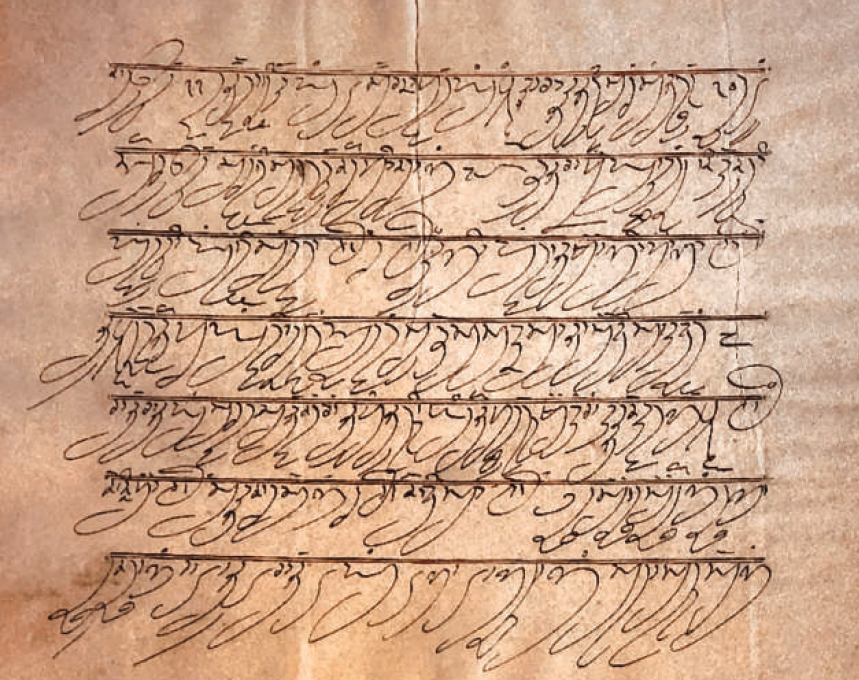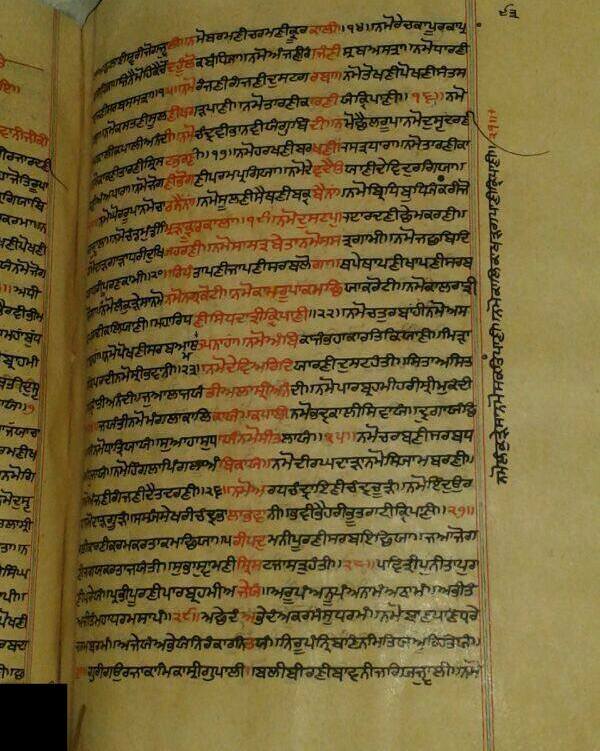|
Bachitra Natak
The ''Bachittar Natak'' or ''Bachitar Natak'' (; 'The Wonderful Play') is partly an autobiography of Guru Gobind Singh. The appellation ''Bachitar Natak'' is sometimes confusingly only applied around the Dasam Granth.Rinehart, Robin. ''Debating the Dasam Granth''. Oxford University Press, 2011. The ''Bachitar Natak Granth'', not to be confused with the ''Bachittar Natak'' composition, contains a large corpus of the Dasam Granth canon. Overview The Bachittar Natak is part of the Dasam Granth, the second holy scripture of Sikhism. The composition covers various aspects, including the lineage of Guru Gobind Singh, the persecution of Guru Tegh Bahadur, the author's own rebirth, and the defense and spread of dharma (righteousness). It also includes descriptions of battles, hunting expeditions, and journeys in Punjab and the Himalayan foothills.Michaud, Heather. ''Walking in the Footsteps of the Guru: Sikhs and Seekers in the Indian Himalayas''. Canada: University of Calgary, 1998. ... [...More Info...] [...Related Items...] OR: [Wikipedia] [Google] [Baidu] |
Sikhism
Sikhism is an Indian religion and Indian philosophy, philosophy that originated in the Punjab region of the Indian subcontinent around the end of the 15th century CE. It is one of the most recently founded major religious groups, major religions and among the largest in the world with about 25–30million adherents, known as Sikhs. Sikhism developed from the spiritual teachings of Guru Nanak (1469–1539), the faith's first guru, and the nine Sikh gurus who succeeded him. The tenth guru, Guru Gobind Singh (1666–1708), named the Guru Granth Sahib, which is the central religious scripture in Sikhism, was their successor. This brought the line of human gurus to a close. Sikhs regard the Guru Granth Sahib as the 11th and eternally living guru. The core beliefs and practices of Sikhism, articulated in the Guru Granth Sahib and other Sikh scriptures, include faith and meditation in the name of the one creator (''Ik Onkar''), the divine unity and equality of all humankind, engaging ... [...More Info...] [...Related Items...] OR: [Wikipedia] [Google] [Baidu] |
Battle Of Nadaun
The Battle of Nadaun, alternatively known as the Hussaini Yudh'','' was fought at Nadaun, between Raja Bhim Chand of Bilaspur (Kahlur) and the Mughals under Alif Khan. Bhim Chand was supported by Guru Gobind Singh (the tenth Sikh Guru) and the Mughals were supported by other hill chieftains, notably Kirpal Chand from Kangra and Dayal Chand from Bijharwal. Bhim Chand and some hill chieftains, after the conclusion of the Battle of Bhangani, had refused to pay tribute to the Mughal emperor which led to the battle at Nadaun. The battle resulted in the victory of Bilaspur State and Sikh alliance. '' Bichitra Natak'', considered to be the autobiography of Guru Gobind Singh, is one of the major sources of information about the battle. However, its authorship is disputed by some scholars. Dating Different authors give the date of the battle variously as 1687, 1689, 1690, 20 March 1691, and 4 April 1691. Cause The Mughal emperor Aurangzeb's Deccan campaigns against Bijapur and ... [...More Info...] [...Related Items...] OR: [Wikipedia] [Google] [Baidu] |
Rudra Avtar
Rudra Avtar (, pronunciation: ) is an epic poetry, epic poem under the title ''Ath Rudra Avtar Kathan''(n). It is traditionally said to have been written by Guru Gobind Singh. It is included in ''Dasam Granth'', which is considered to be the second-most important scripture of the Sikhs. It is sometimes grouped together with the preceding ''Brahma Avtar'' composition into a combination termed as the ''Upāvatār'' (meaning "lesser avatars"). Synopsis The Rudra Avtar covers the stories of two avatars, or incarnations, related to ''Rudra'' or ''Shiva.'' This composition covers the most important wars within Sikh philosophy, such as the fight between ''Bibek Buddhi'' and ''Abibek Budhi,'' (truth and falsity), and the fight between wisdom and ignorance.Dasam Granth, S.S. Kapoor, Page 17 This composition covers the concepts of ''Gyaan'' (Knowledge) and ''Dhyana'' (Attention) and is against fake ritualism and practices. Incarnations of Rudra (Shiva) Guru Gobind Singh sanctified an ... [...More Info...] [...Related Items...] OR: [Wikipedia] [Google] [Baidu] |
Chaubis Avtar
''Chaubis Avtar'' (, pronunciation: ) is a composition in Dasam Granth containing history of 24 incarnations ('' avatars'') of Vishnu. Synopsis It is traditionally and historically attributed to Guru Gobind Singh. However, the opening lines of the work use a pen-name of ''Siām'', which some argue was one of the court poets of the Guru whilst others believe it was one of the Guru's pen-names. The composition covers 30% of the Dasam Granth containing 5571 verses with longest sub compositions being Krishna Avtar and Rama avtar, having 2492 and 864 verses each. The Kalki avtar chapter contains 588 verses. The ''Chaubis Avtar'' is part of all five known major historical variants of ''Dasam Granth'', but they are sequenced differently in these editions.J Deol (2000), Sikh Religion, Culture and Ethnicity (Editors: AS Mandair, C Shackle, G Singh), Routledge, , pages 31-33 The text is notable for naming Jaina Arihanta as an avatar of Vishnu who practiced asceticism, forbade Yajna an ... [...More Info...] [...Related Items...] OR: [Wikipedia] [Google] [Baidu] |
Chandi Charitar II
''Chandi Charitar II'' or ''Chandi Charitar Duja or Ath Chandi Charitar Likhyate'' (), is the 5th chapter of the Dasam Granth, whose authorship is generally attributed to Guru Gobind Singh. The plot of the text is based on the Markandeya Purana,Macauliffe, Max Arthur (28 March 2013). ''The Sikh Religion: Its Gurus, Sacred Writings and Authors, Volume 5''. Cambridge University Press. pp. 80, 81. much like the previous Chandi Charitar I.Chandi Di Vaar : Jeet Singh Sital A retelling of the story of the Hindu goddess, Durga again in the form of Chandi; it again glorifies the feminine with her fighting the war between good and evil, and in this section she slays the buffalo-demon Mahisha, all his associates and supporters thus bringing an end to the demonic violence and war. Overview This composition deals with themes of battle and war. Its authorship is generally and traditionally attributed to Guru Gobind Singh. This composition was written in Braj at Anandpur Sahib, Punjab. ... [...More Info...] [...Related Items...] OR: [Wikipedia] [Google] [Baidu] |
Chandi Charitar Ukti Bilas
''Chandi Charitar Ukti Bilas'' or ''Chandi Charitar Ukat(i) Bilas'' (, pronunciation: ), also called Chandi Charitar 1 (ਚੰਡੀ ਚਰਿਤ੍ਰ (ਭਾਗ ੧)) or Chandi Charitar Part One is a heroic poetic composition, included as the 4th chapter of Dasam Granth, whose authorship is generally and traditionally attributed to Guru Gobind Singh. Though it is based on Markandeya Purana, the direction and narration of whole story is independent of the Markandeya Purana. Overview The text follows the Bachitar Natak and is itself followed by Chandi Charitar II. The text states it is retelling the ''Markandeya Purana'' story, where Durga fights a shape shifting buffalo demon Mahishasura and slays the evil demon and his companions. The names Chandi and Chandika are also used to refer to the ''devi'' (goddess). It is based specifically on the ''Devi Mahatmya, Durga Saptasati'' chapter of the Markandeya Purana''.'' Chandi Charitar II repeats the same storyline in a shorter fo ... [...More Info...] [...Related Items...] OR: [Wikipedia] [Google] [Baidu] |
Diagram Showing The Relationship Between The "Dasam Granth", "Bachittar Natak Granth", And "Bachittar Natak" Composition
A diagram is a symbolic representation of information using visualization techniques. Diagrams have been used since prehistoric times on walls of caves, but became more prevalent during the Enlightenment. Sometimes, the technique uses a three-dimensional visualization which is then projected onto a two-dimensional surface. The word ''graph'' is sometimes used as a synonym for diagram. Overview The term "diagram" in its commonly used sense can have a general or specific meaning: * ''visual information device'' : Like the term "illustration", "diagram" is used as a collective term standing for the whole class of technical genres, including graphs, technical drawings and tables. * ''specific kind of visual display'' : This is the genre that shows qualitative data with shapes that are connected by lines, arrows, or other visual links. In science the term is used in both ways. For example, Anderson (1997) stated more generally: "diagrams are pictorial, yet abstract, representatio ... [...More Info...] [...Related Items...] OR: [Wikipedia] [Google] [Baidu] |
Rehat
Rehat (Punjabi language, Punjabi: ਰਹਿਤ, alternatively transliterated as Rehit, Rahit, or Rahat) refers to the rules and traditions which govern the unique Sikh lifestyle and determines correct Sikh orthodoxy and orthopraxy. The Sikh Rehit Maryada(Punjabi language, Punjabi: ; also transcribed as Sikh Reht Maryada or Khalsa Rehat Maryada) is a code of conduct and conventions for Sikhism. The final version of the Rehat Maryada was controversially approved by the Shiromani Gurdwara Parbandhak Committee, Amritsar in 1945. The Rehat Maryada was created to provide guidance to Sikhs (and those desirous of embracing the Sikh faith) on practical and functional aspects of daily life, including the operations of Sikh Gurdwaras, and religious practices to foster cohesion throughout the community.Singh, Kulraj. 31 August 1994.Preface to the English Version of Reht Maryada" In ''Sikh Reht Maryada''. Amritsar. Shiromani Gurdwara Parbandhak Committee. Retrieved 10 July 2020. Rehitnāma (mea ... [...More Info...] [...Related Items...] OR: [Wikipedia] [Google] [Baidu] |
Prince Muazzam
Bahadur Shah I (Muhammad Mu'azzam; 14 October 1643 – 27 February 1712) or Shah Alam I, was the eighth Mughal Emperor from 1707 to 1712. He was the second son of the sixth Mughal emperor Aurangzeb, who he conspired to overthrow in his youth. He was also the governor of the imperial provinces of Agra, Kabul and Lahore and had to face revolts of Rajputs and Sikhs. After Aurangzeb's death, Muhammad Azam Shah, his third son by his chief consort Nawab Bai declared himself successor, but was shortly defeated in one of the largest battles of India, the Battle of Jajau and overthrown by Bahadur Shah. During the reign of Bahadur Shah, the Rajput kingdoms of Jodhpur and Amber were annexed again after they had declared independence a few years prior. Bahadur Shah also sparked an Islamic controversy in the ''khutba'' by inserting the declaration of Ali as ''wali''. His reign was disturbed by several rebellions, the Sikhs under the leadership of Banda Singh Bahadur, Rajputs under Durga ... [...More Info...] [...Related Items...] OR: [Wikipedia] [Google] [Baidu] |



